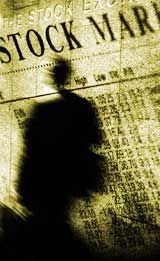NYT study finds 41% of firms receiving buyout bids in last year show 'abnormal and suspicious' trading before deals went public


RAW STORYPublished: Saturday August 26, 2006
A NY Times study finds that 41% of companies receiving buyout bids in the last twelve months show "abnormal and suspicious trading" before the deals became public.
"The boom in corporate mergers is creating concern that illicit trading ahead of deal announcements is becoming a systemic problem," writes Gretchen Morgenson for the Times.
"It is against the law to trade on inside information about an imminent merger, of course," Morgenson writes.
"But an analysis of the nation’s biggest mergers over the last 12 months indicates that the securities of 41 percent of the companies receiving buyout bids exhibited abnormal and suspicious trading in the days and weeks before those deals became public," the article continues. "For those who bought shares during these periods of unusual trading, quick gains of as much as 40 percent were possible."
Excerpts from the Times article:
#
The study, conducted for The New York Times by Measuredmarkets Inc., an analytical research firm in Toronto, scrutinized mergers with a value of $1 billion or more that were announced in the 12-month period that ended in early July. The firm analyzed the price, the total number of shares traded and the number of individual trades in each stock during the weeks leading up to the announcement and looked for large deviations from trading patterns going back as far as four years.
There are many possible aboveboard explanations for such trading activity. A company may have generated news that had nothing to do with a potential merger — about business operations or a prominent executive, for instance — that prompted a trading spike. There may have been developments in a particular industry sector that influenced investors’ trading decisions. Or an influential newsletter, columnist or blogger could have written something that moved a market.
Nevertheless, deviations of the kind observed by Measuredmarkets are among the data used by regulators to spot insider trading. And Christopher K. Thomas, a former analyst and stockbroker who founded Measuredmarkets in 1997, said that his company’s analysis led to the conclusion that the aberrant activities that it found were most likely cases of insider trading.
#
FULL TIMES ARTICLE CAN BE READ AT THIS LINK




0 Comments:
Post a Comment
<< Home